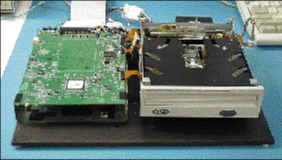Magneto-optic memory storage drive terminology
Here are definitions for some common acronyms
describing magneto-optic (MO) drives
BY GARY POTTS
Maxoptix
Fremont, CA
Changes in the data storage industry have produced a crop of terminology that shows up only as a grouping of letters. As in other technical industries, the meaning behind the letters sometimes becomes a clouded memory over time. Here are some of the current concepts “behind the letters” for magneto-optic memory storage devices.

One of a breed of new storage technologies, Maxoptix's Optical Super Density increases data storage density and transfer speeds for removable MO drives.
Numerical aperture A larger numerical aperture (NA) of a lens indicates a sharper and brighter image. When applied to the laser component of MO drives, a larger number will indicate a smaller diameter of light incident or spot upon the disk. The NA of the lens in a typical ISO-standard product is 0.55; improvements in laser, lens, and fiber-optic technology will continue to raise this number toward 1.0, the refractive limit of a dry lens. Overcoat incident recording Today's hard disks have the recording layer on top of a substrate, a construction known as incident recording. A very thin coating, in the range of a few angstroms, covers the recording surface to provide lubrication in the event of a momentary impact by the head. An ISO-standard MO drive has a transparent substrate on top of the recording layer, through which the laser light passes during record routines. This construction is known as substrate incident recording. The substrate protects the recording layer from contamination and oxidation, but due to its thickness, limits the numerical aperture that can be used in the objective lens. This is a primary limiting factor to the capacity and performance of ISO-type MO drives. Surface array recording Surface array recording (SAR) is the process of accessing both sides of the disk simultaneously. Traditional removable MO drive users are required to flip the media in order to read data stored on the opposite side of the disk. Hard disks use multiple read/write heads, but because the heads are not independent, the active pickup must switch from one side (or head) to the other, resulting in data rates no greater than the data rate of single-surface media. SAR provides simultaneous read or write to both sides of the media, resulting in data rates nearly twice the single side and very similar to that of hard-disk products. Recessed objective lens Recessed objective lens (ROL) refers to the positioning of the lens above the magnetic head so that it will not be subjected to particulate contamination that may be introduced into the drive during media insertion. In addition, by decoupling the objective lens from the magnetic head in the vertical direction, continuous focus is achieved, improving the reliability of the drive by allowing it to adapt to a wider range of environmental conditions. Magnetic-field modulation Because of the recording head's distance from the media, traditional MO drives use a large coil sufficient to produce flux needed to write data. The switching frequency of the magnetic field is slow because of the high inductance of the large coil. With the slow switching frequency of the MO coil, marks on the disk cannot overlap and have an aspect ratio of 1:1, which makes the wavelength of the laser the limiting factor to bit density. Magnetic-field modulation (MFM) removes these limitations. By using a small magnetic head in close proximity to the disk, the polarity of the magnetic field can be switched at a very high frequency. The quick changes in polarity produce overlapping spots resulting in recording marks on the disk that are narrow and tall, often referred to as crescents. These crescent-shaped marks provide a significant increase in bit density. Magnetic super resolution By using MFM, the limiting factor on bit density shifts from the wavelength of the laser to the ability to isolate individual marks during readback operations using a laser spot that may cover several marks. Magnetic super resolution (MSR) is a masking technology that enables read back of very high bit densities by isolating the individual bit to be read. During the read process, more energy is applied to the disk to preheat what is referred to as a readout layer that lies on top of the recording layer. The readout layer magnifies the bit area, providing higher resolution for progressively smaller bits. In the future, in addition to isolating the bits to be read, MSR improvements will provide amplification of the reflected signal, which will allow the read back of ever-smaller marks. Blue laser It is anticipated that, by the year 2002, the market will see the first products featuring reliable blue-laser technology. Blue lasers (approximately 410 nm) will provide a spot incident 30% smaller than is possible with today's red lasers (650 nm). Blue lasers will effectively double capacity to between 80 and 100 Gbytes on a singe 5.25-in. disk. The future Responding to the market's demand for storage systems with more capacity, higher reliability, and smaller size, products such as Maxoptix's Optical Super Density (OSD) drives are combining proven storage technologies in new and innovative ways to virtually revolutionize data storage on a regular basis. As thinner overcoatings are developed, as lenses approach the 1.0-NA horizon, as laser and magnetic resolutions are fine tuned toward their theoretical limits, and as science continues to reposition those limits, transportable MO will continue to be a viable data storage technology.
Advertisement





